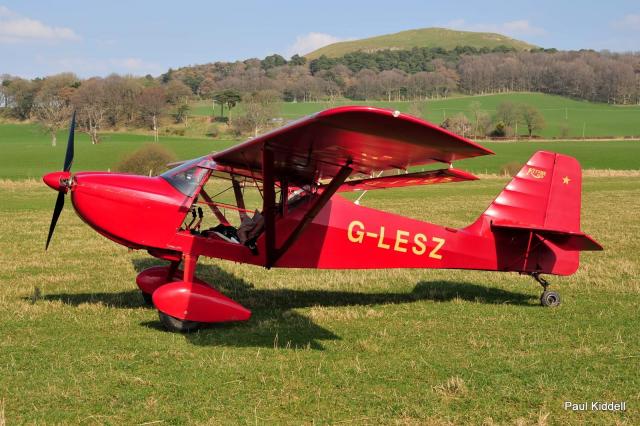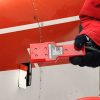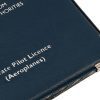Denny Kitfox
The Denny Kitfox is built with simplicity and performance in mind. It features a welded steel-tube fuselage covered with lightweight fabric and an aluminum wing structure. The aircraft’s distinctive high-lift, high-wing design and large flaps allow for remarkable STOL performance, enabling takeoff and landing on short, rough airstrips.
The Kitfox’s signature folding wing system allows the aircraft to be stored in tight spaces or transported by trailer, making it ideal for pilots with limited hangar space. Its tailwheel landing gear configuration enhances its off-airport performance, and optional tricycle gear is also available.
The cockpit is designed for comfort and functionality, with side-by-side seating, dual controls, and a modern instrument panel that supports traditional gauges or glass cockpit avionics. With its expansive windows and high-wing configuration, visibility is exceptional, providing breathtaking views during flight.
Specifications
| General Specifications | Details |
|---|---|
| Manufacturer | Denney Aerocraft / Kitfox Aircraft LLC |
| Role | Recreational, Sport, Backcountry Flying |
| Seating Capacity | 2 (Side-by-side) |
| Length | 19 ft 0 in (5.79 m) |
| Wingspan | 32 ft 0 in (9.75 m) (varies by model) |
| Height | 6 ft 8 in (2.03 m) |
| Wing Area | 132 sq ft (12.3 m²) |
| Empty Weight | 750–850 lbs (340–386 kg) (depending on model) |
| Max Takeoff Weight (MTOW) | 1,320–1,550 lbs (600–703 kg) |
| Engine Options | Rotax 912ULS (100 hp), Rotax 915iS (141 hp), or similar |
| Propeller | Fixed-pitch or constant-speed |
| Fuel Capacity | 27–40 gallons (102–151 liters) |
| Range | 600–800 nautical miles (1,111–1,482 km) |
| Cruise Speed | 100–120 knots (115–138 mph / 185–222 km/h) |
| Stall Speed (Flaps Down) | 35–40 knots (40–46 mph / 64–74 km/h) |
| Rate of Climb | 1,200–1,500 ft/min (366–457 m/min) |
| Service Ceiling | 16,000+ ft (4,877 m) |
| Takeoff Distance (50 ft obstacle) | 300–400 ft (91–122 m) |
| Landing Distance (50 ft obstacle) | 350–450 ft (107–137 m) |
Performance
The Denny Kitfox is renowned for its outstanding STOL capabilities, capable of operating from short, rough, or even remote airstrips. Depending on the engine configuration, the Kitfox can cruise comfortably at speeds of 100 to 120 knots, offering solid cross-country performance while maintaining excellent fuel efficiency. With a range of up to 800 nautical miles, it’s suitable for extended trips and adventure flying.
The Kitfox’s low stall speed of 35 to 40 knots ensures safe, controlled landings even on challenging terrain. Its lightweight frame and high-lift wings provide responsive handling, allowing pilots to perform tight turns and precise maneuvers when navigating confined areas like mountain valleys or remote backcountry fields.
For added versatility, many Kitfox models can be equipped with tundra tires, floats, or skis, making the aircraft adaptable to virtually any environment. Its powerful engines and excellent climb rate enable operation from high-altitude airfields and mountainous regions with ease.
Conclusion
The Denny Kitfox is a true adventure aircraft, combining rugged design with exceptional performance. Its unique blend of STOL capabilities, folding wings, customizable configurations, and proven reliability makes it a top choice for pilots seeking backcountry flying adventures, cross-country touring, or recreational aviation. Whether flying for fun or exploring the wilderness, the Kitfox remains a beloved aircraft among aviation enthusiasts worldwide.
Denny Kitfox FAQ
1. What is the Denny Kitfox?
The Denney Kitfox is a light, two-seat, high-wing, tailwheel aircraft known for its STOL (Short Takeoff and Landing) capabilities. It’s popular in the homebuilt and sport aviation communities due to its customizable design and impressive backcountry performance.
2. Who manufactures the Kitfox?
Initially designed by Dan Denney in 1984, the Kitfox is now manufactured by Kitfox Aircraft LLC. The company supports homebuilders with aircraft kits, components, and maintenance services.
3. Is the Kitfox a certified aircraft?
No, the Kitfox is not FAA-certified. It is an experimental amateur-built (E-AB) aircraft, which requires owners to assemble and maintain it following FAA regulations for homebuilt aircraft.
4. What are the seating arrangements?
The Kitfox features two seats in a side-by-side configuration, providing ample cabin space for both pilot and passenger, making it suitable for recreational flying, cross-country trips, and backcountry adventures.
5. What engines can power the Kitfox?
Common engines include the Rotax 912, 914, and 915 iS, as well as Continental and Jabiru options. The Rotax series is the most popular due to its reliability, fuel efficiency, and performance.
6. What is the Kitfox’s maximum cruise speed?
The cruise speed of the Kitfox varies by model and engine, typically ranging from 95 to 130 mph (83 to 113 knots). It balances speed with low-speed stability for off-airport landings.
7. What is the takeoff distance for the Kitfox?
The Kitfox excels in STOL performance, taking off in as little as 200-300 feet, depending on the engine, weight, and runway surface, making it ideal for backcountry flying and unimproved strips.
8. How much does a Kitfox cost?
The Kitfox kit price ranges from $25,000 to $60,000, depending on the model and included options. Fully built, customized Kitfox aircraft can cost upwards of $100,000.
9. What is the Kitfox’s range?
With standard fuel tanks, the Kitfox has a range of approximately 700-800 miles, depending on cruise settings, fuel load, and wind conditions. Extended-range fuel tanks are available for longer flights.
10. Can the Kitfox be used for bush flying?
Yes, the Kitfox is highly regarded for bush flying due to its STOL capabilities, rugged landing gear, and ability to operate from grass, sand, and gravel strips.
11. What is the maximum takeoff weight (MTOW)?
Depending on the model, the Kitfox’s MTOW typically ranges from 1,200 to 1,550 pounds. Builders can configure the aircraft to meet specific mission profiles while staying within FAA limits.
12. What fuel does the Kitfox use?
Most Kitfox models use 91-octane mogas or 100LL avgas, depending on the engine. The Rotax engines are particularly flexible, offering fuel efficiency and multi-fuel compatibility.
13. What avionics are included?
The Kitfox supports a wide range of avionics, from basic analog instruments to advanced glass cockpits like Garmin G3X and Dynon SkyView. Builders can choose systems based on budget and mission requirements.
14. Is the Kitfox suitable for beginners?
Yes, with proper training, the Kitfox can be a good aircraft for beginners. Its forgiving flight characteristics, slow landing speed, and excellent visibility make it a popular choice for new pilots.
15. How difficult is Kitfox assembly?
Kitfox assembly is considered manageable for homebuilders with basic mechanical skills. The kit includes pre-fabricated parts, detailed instructions, and factory support, with average build times ranging from 1,000 to 1,500 hours.
16. Can the Kitfox be equipped with floats?
Yes, the Kitfox can be fitted with amphibious or straight floats for water operations. Its lightweight design and powerful engines allow for excellent water takeoff performance.
17. What maintenance does the Kitfox require?
Regular maintenance includes engine servicing, airframe inspections, and control system checks. Since it’s an experimental aircraft, owners can perform maintenance themselves under FAA regulations after proper certification.
18. What are the landing requirements?
The Kitfox can land on runways as short as 300-400 feet, depending on load and wind conditions. It’s designed for rough field landings, including sandbars, grass strips, and mountain terrains.
19. Is the Kitfox suitable for cross-country flights?
Yes, the Kitfox’s fuel efficiency, cruise speed, and long range make it suitable for cross-country flights. Its high wing and large windows offer excellent visibility for scenic routes.
20. How customizable is the Kitfox?
The Kitfox is highly customizable, offering options such as tundra tires, extended-range fuel tanks, glass cockpits, folding wings, and upgraded interiors. Builders can tailor the aircraft to match specific flight missions.








